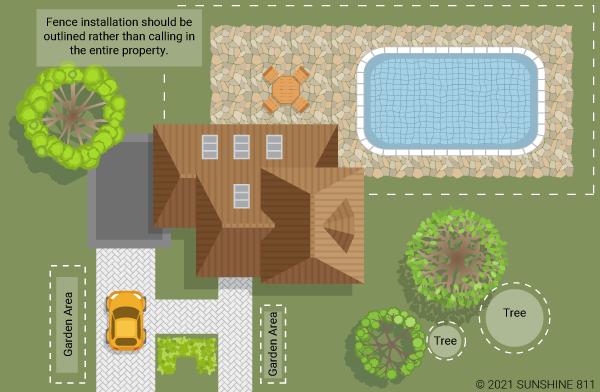Low Impact Marking
Whether requesting a new locate ticket or renewing an existing ticket, excavators are required to follow low impact marking practices. This begins with the locate description on your ticket. The practices outlined below serve four purposes:
Helps ensure the locate is accurate
Reduces unnecessary locate marks
Reduces the amount of time locate marks are refreshed
Reduces time for the locator
Ticket size
ONE MILE
One ticket may cover a linear distance of up to one mile on a street and up to 150 feet in either direction along crossing streets that are identified in the ticket.
5 ADDRESS TICKET
One ticket may cover up to five individual addresses as long as the linear distance from the first address to the last is one mile or less. For example, a single ticket can cover work being done at the addresses below: 2000, 2003, 2004, 2006 and 2009 Main Street. List the individual address numbers in the Locate Description.
UNDEVELOPED LAND TICKET
One locate ticket may cover an area of undeveloped land of no more than one square mile. The boundaries of the work area MUST be described on the ticket. This ticket may also include work on any single street or right-of-way bordering the area of undeveloped land. Work to be performed on an additional bordering street or right-of-way requires a separate ticket.
Ticket requests
Only get tickets for areas where digging will occur within 30 calendar days of the date the ticket is requested. Know the job site and give an accurate description of where it is located. Addresses, street intersections, railroad tracks, references to natural landmarks and driving directions are helpful. Just win a bid for a 10-mile project? Get tickets as you move through the project - not all 10 miles at once.
Ticket renewals
When renewing tickets, revise the locate description to include the next 30 days’ worth of digging. Make sure that your office staff calls the field contact to confirm whether the locate ticket should be renewed and clarify what portion of the work site is incomplete. ***IMPORTANT*** If your office staff renews tickets, let them know when an ongoing project is complete so that tickets are not continually requested for that job. Continuing to renew tickets without changing the locate description is a citable offense.
White lining
If working in a few small areas along a mile of roadway, outline those areas with white paint. This makes it much easier for the locator to mark the exact area where you are digging, finish your job and move on to the next more quickly.
If you're installing a fence that doesn't enclose the entire yard (top right), use white paint to mark the outer edge of the fence line rather than asking for the enire yard to be marked.
When landscaping small plant beds or just a few large larger plants, outline those areas with white paint. This makes it much easier for the locator to mark the exact area where you are digging, finish your job and move on to the next more quickly.
The orange circles above show the two areas where new traffic poles will be placed.
Your locate description should cover only the areas where you will be digging. White line around the two poles and include that information on the ticket; or request locates for the SE and SW corners at the intersection of Main and Division Streets.
Markings
Acceptable marking products for pre-marking a proposed excavation in white or marking underground facilities: flags, stakes, temporary/non-permanent paint, other industry accepted low-impact marking practices. Members are required to mark their underground facilities in appropriately designated colors.
Other helpful tips
Provide the exact location and approximate depth of your excavation.
Note any special conditions that may interfere with the locator doing his job such as a gated community, locked fences or a gate code.
If digging in one corner of an intersection, don't have the ticket cover an entire block. For example, you could specify that you're digging in the northeast corner or use a landmark to identify the corner.








